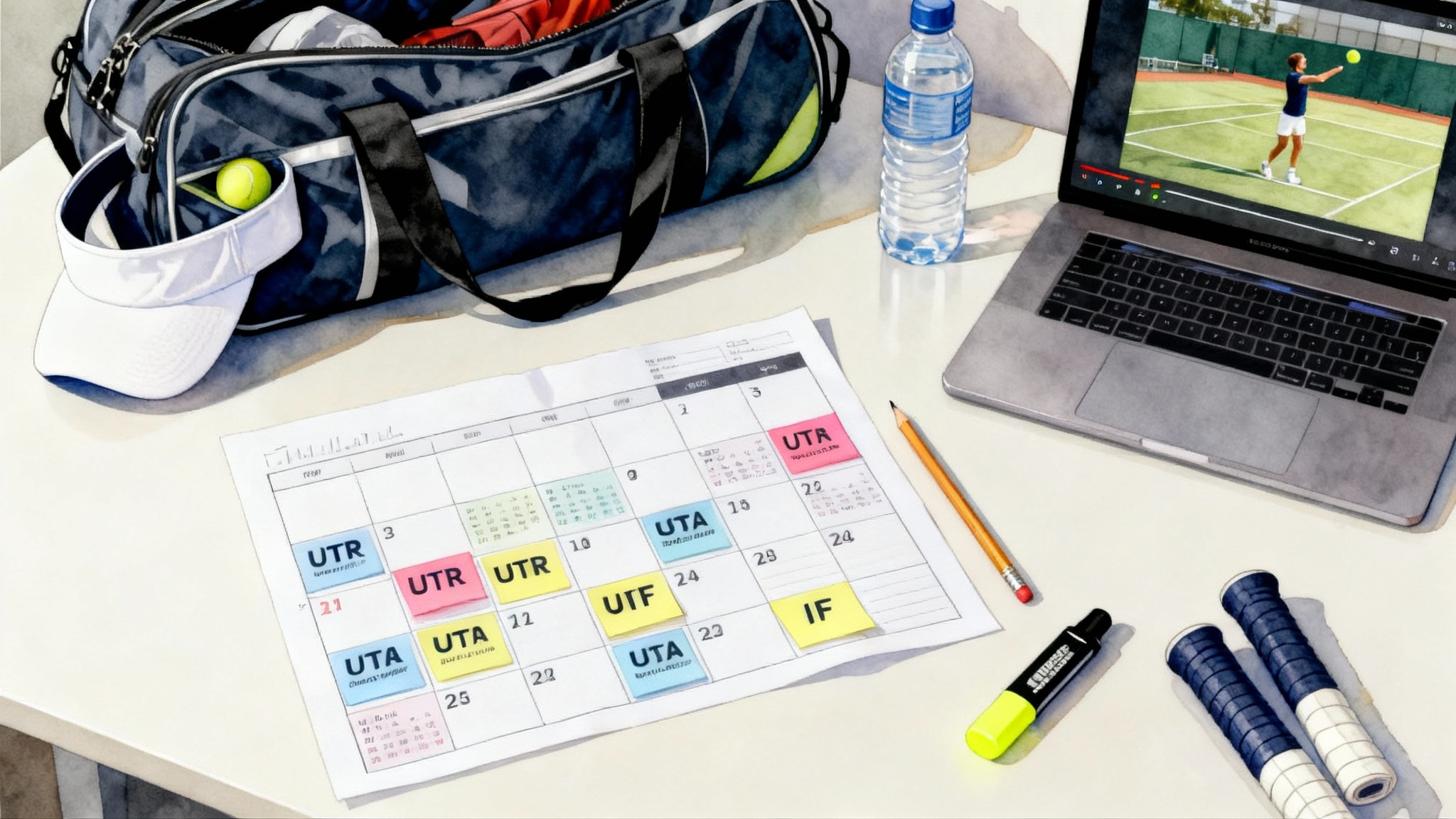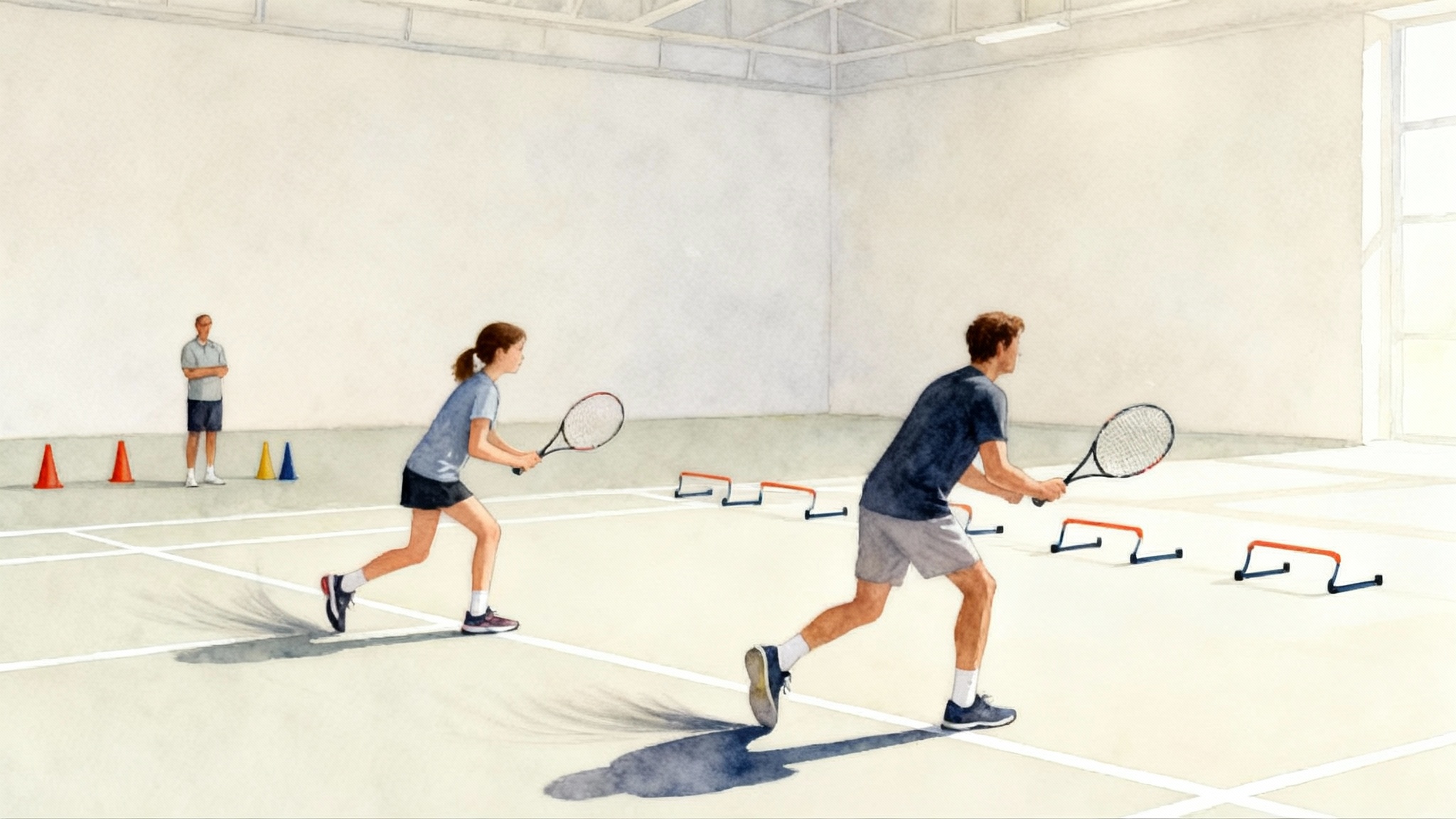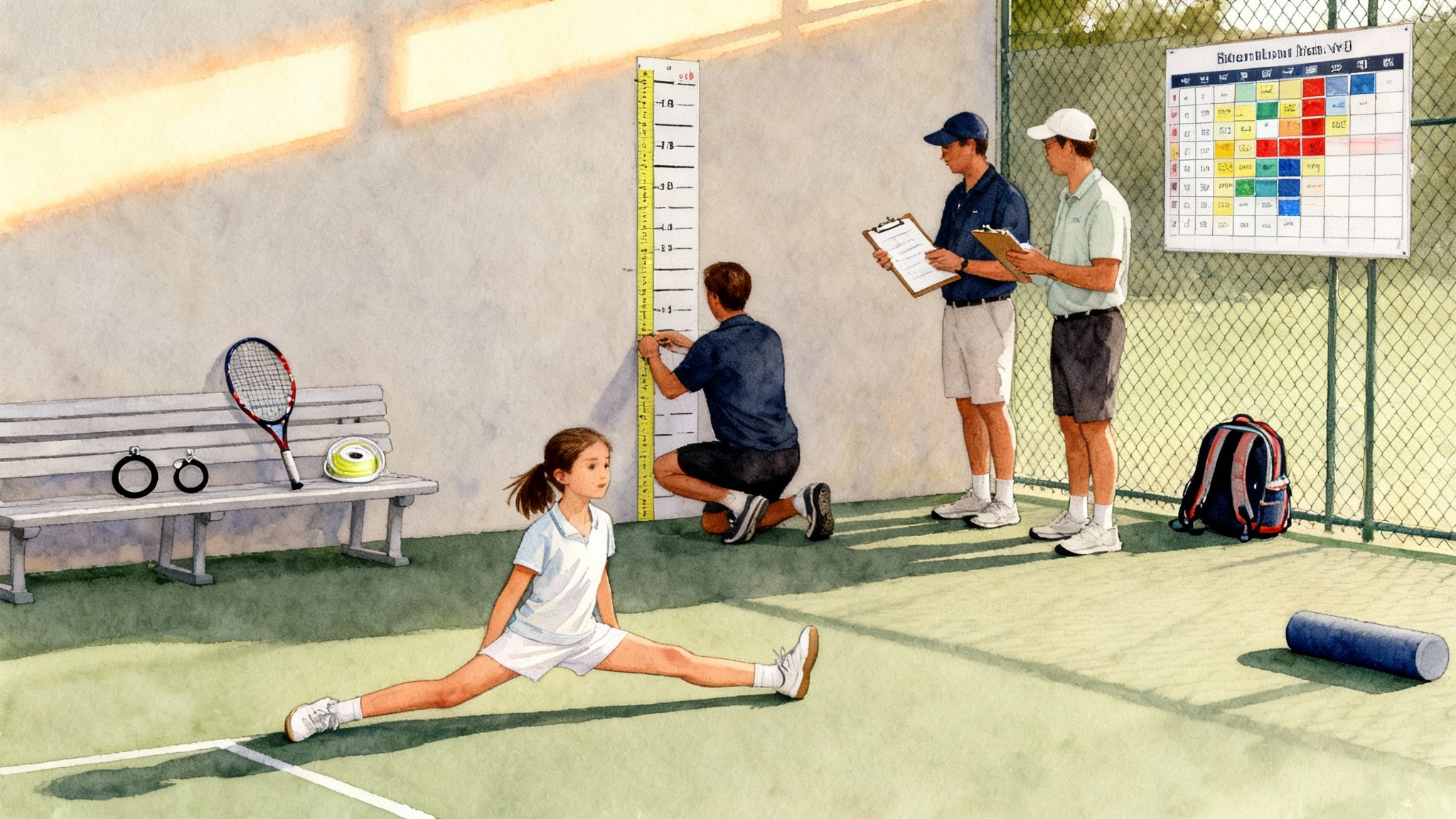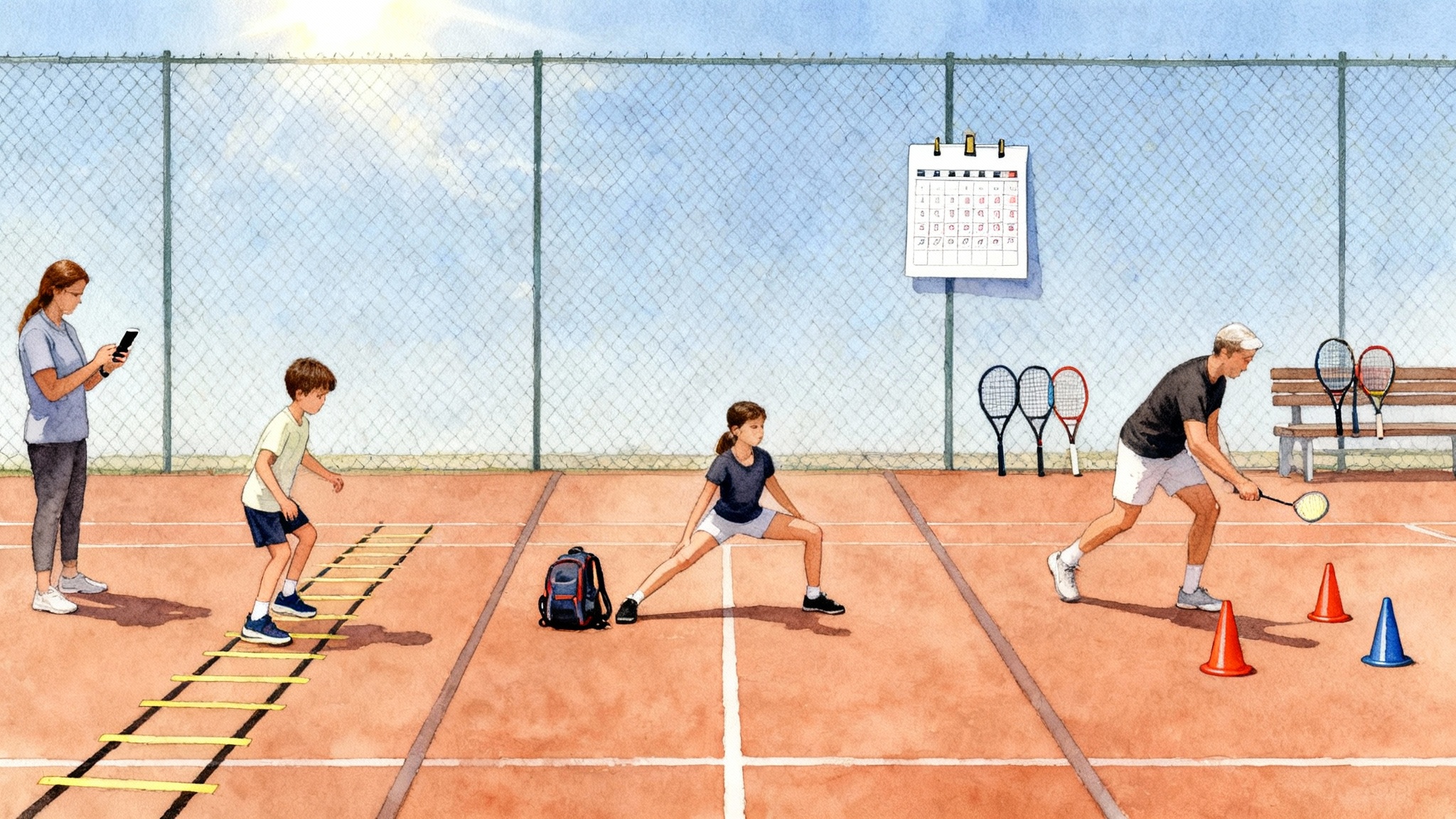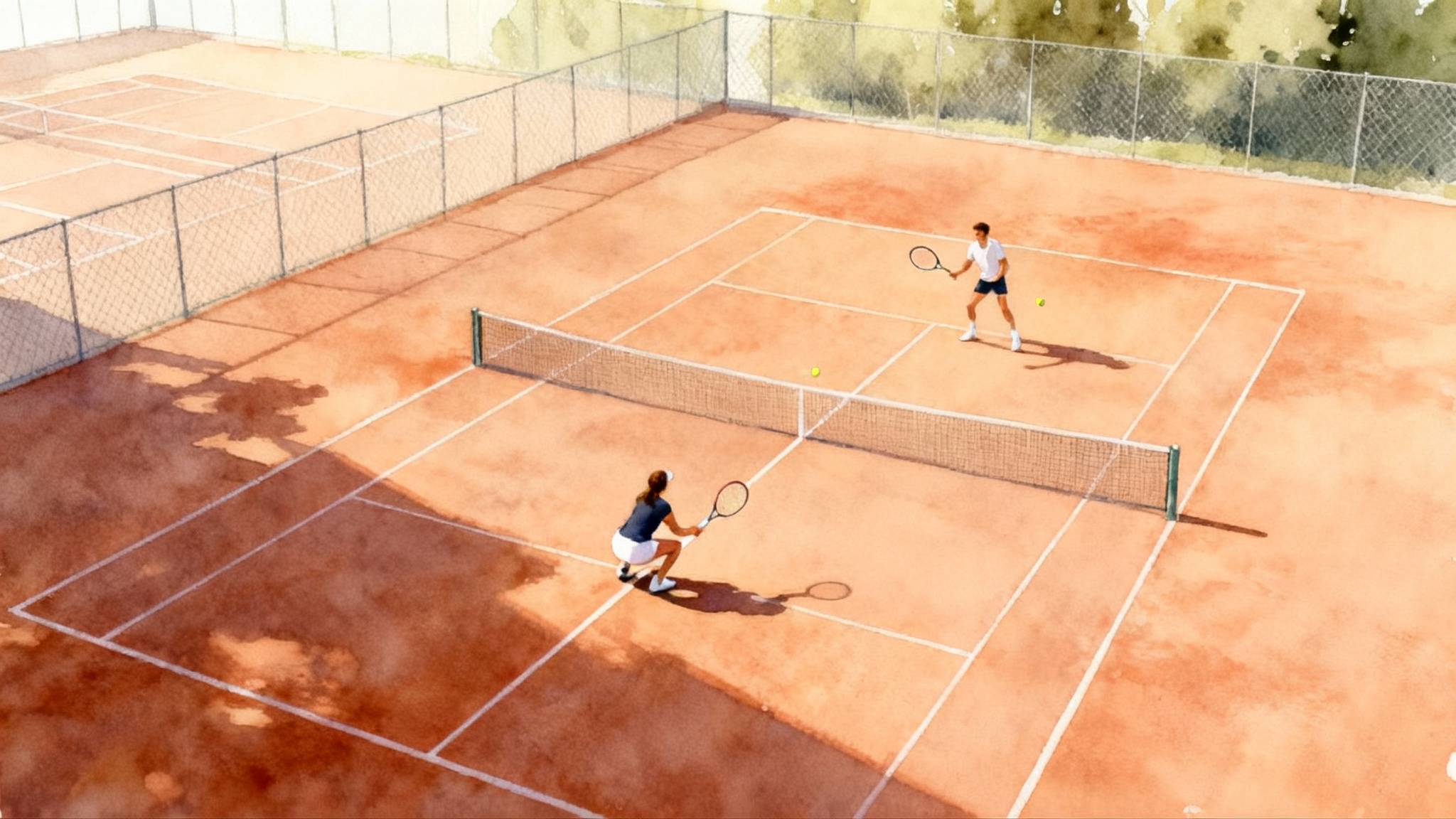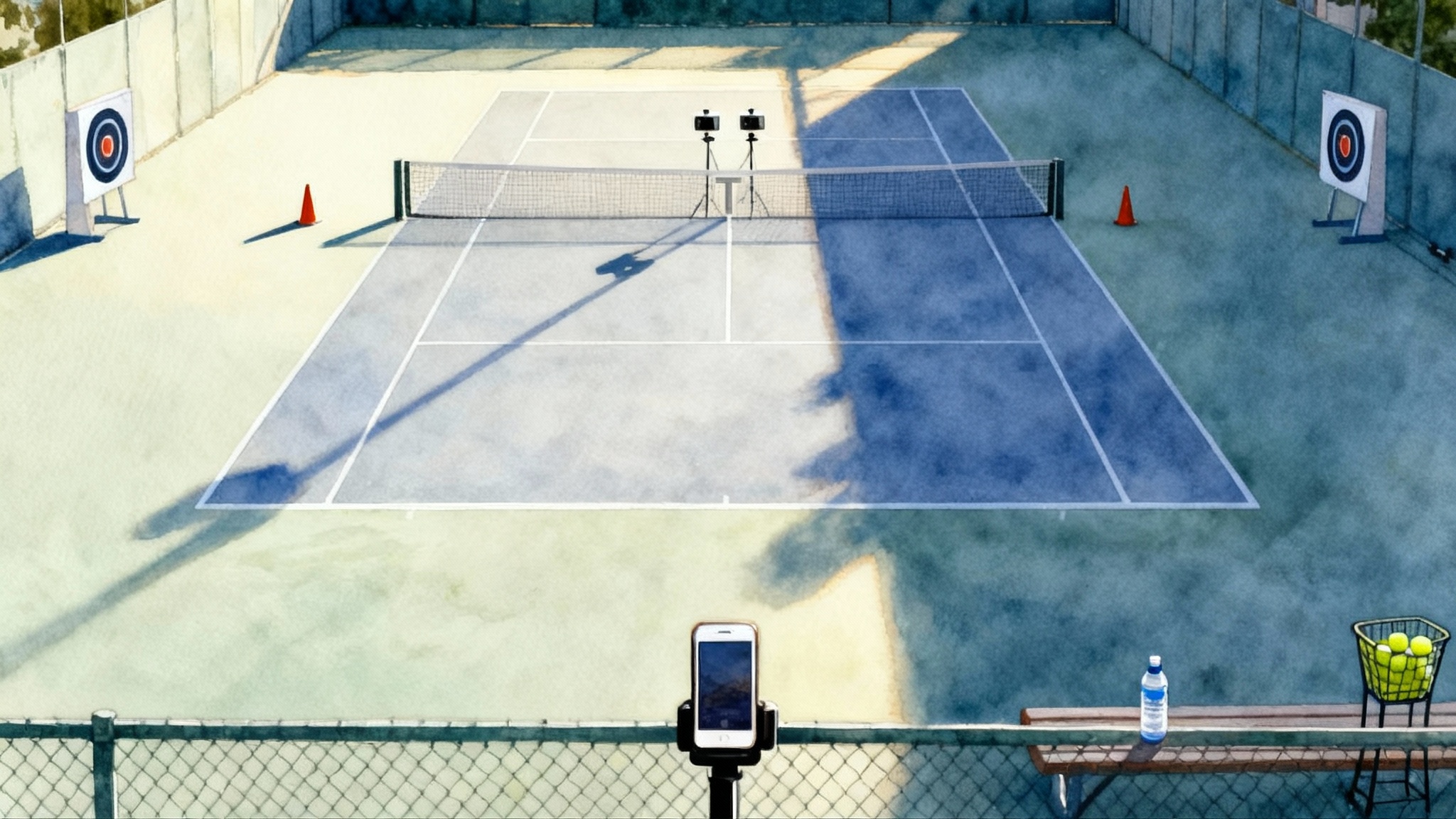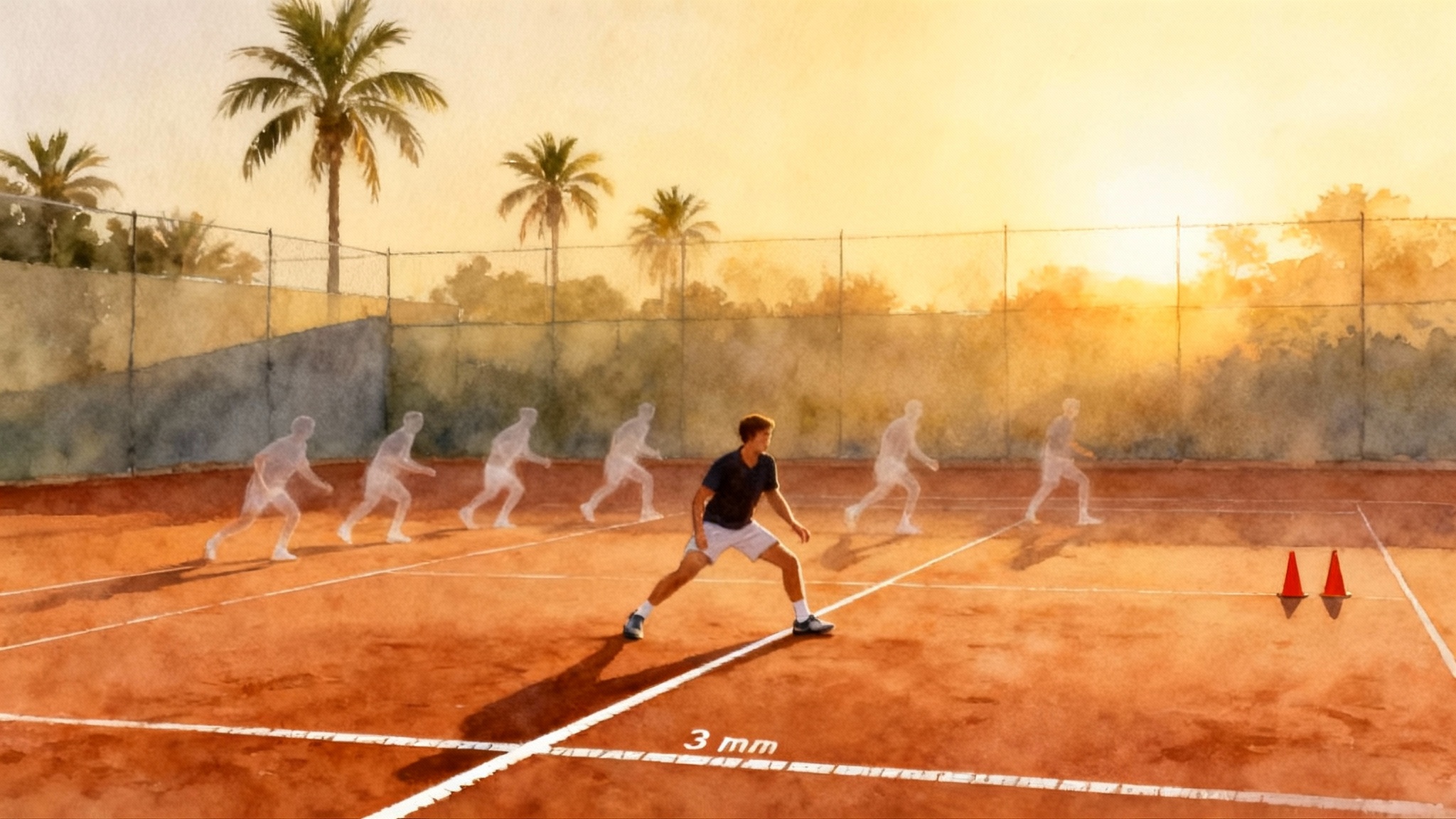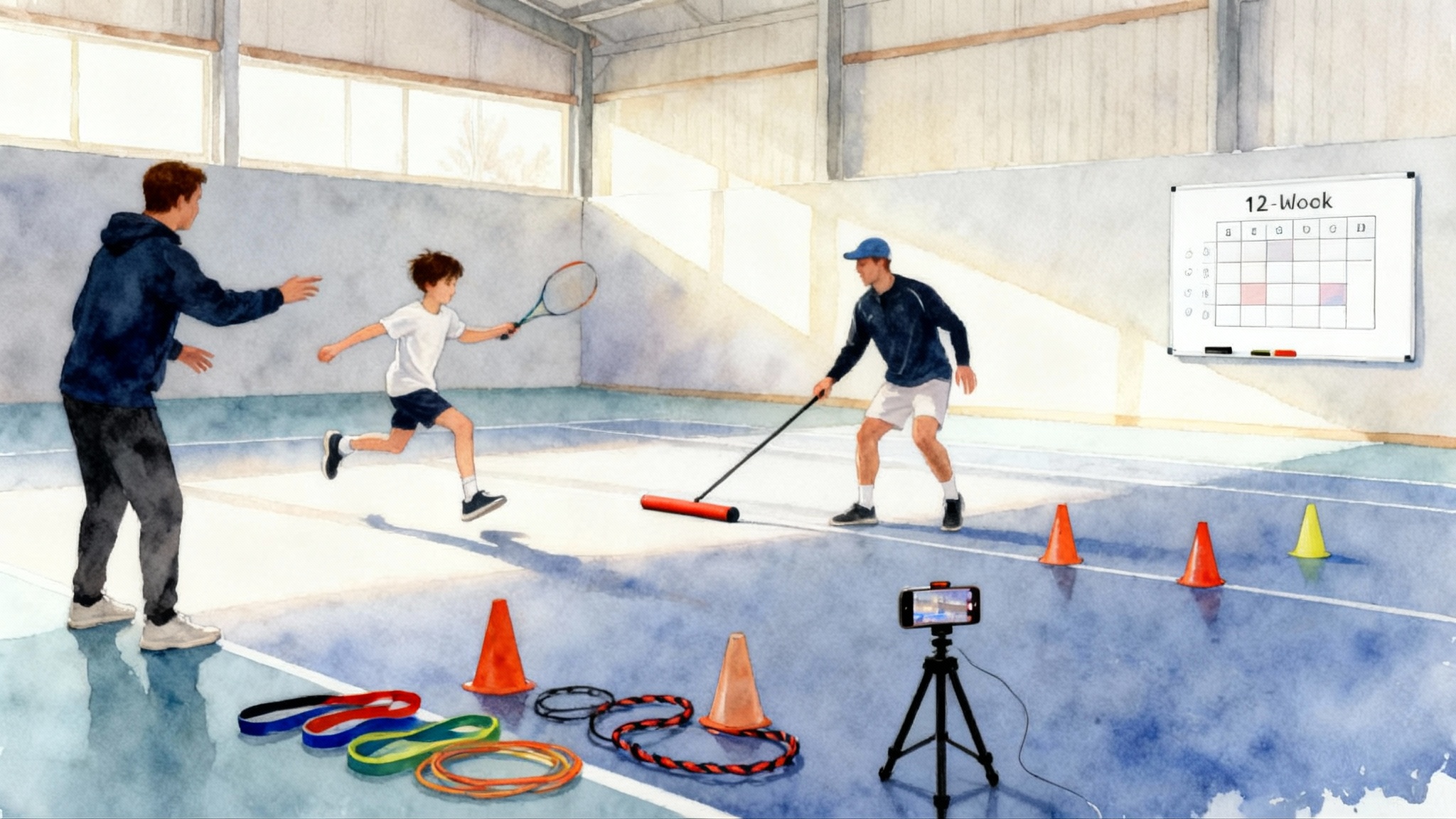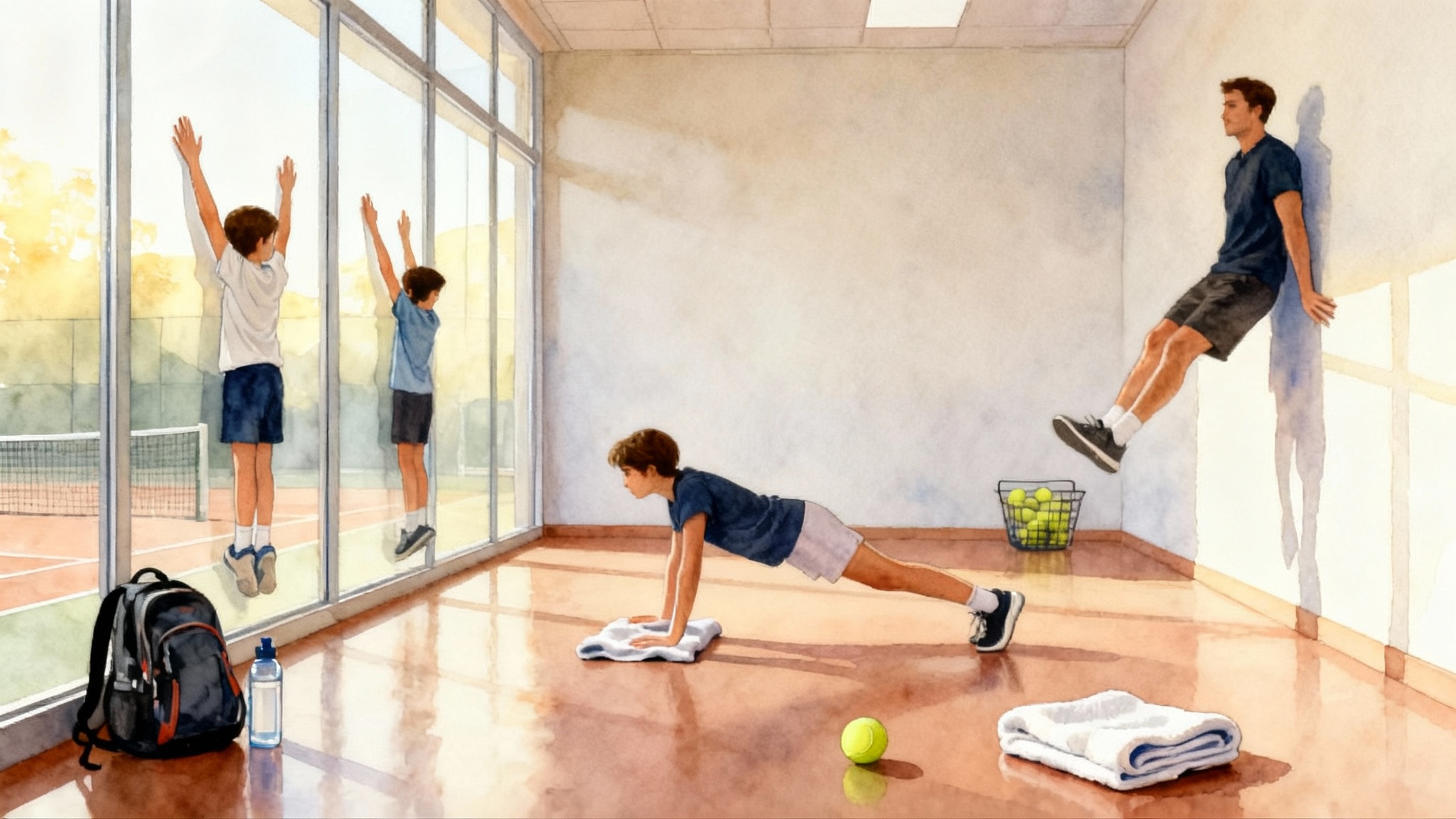Heat-Ready Tennis 2025: Hydration, Cooling, Cramp Prevention
A tournament-day playbook for hot conditions. Use heat-index tiers, age-specific fluid and sodium targets, proven cooling tactics, a travel-kit checklist, and emergency cramp triage. Includes a Florida case study and camp acclimation plan.
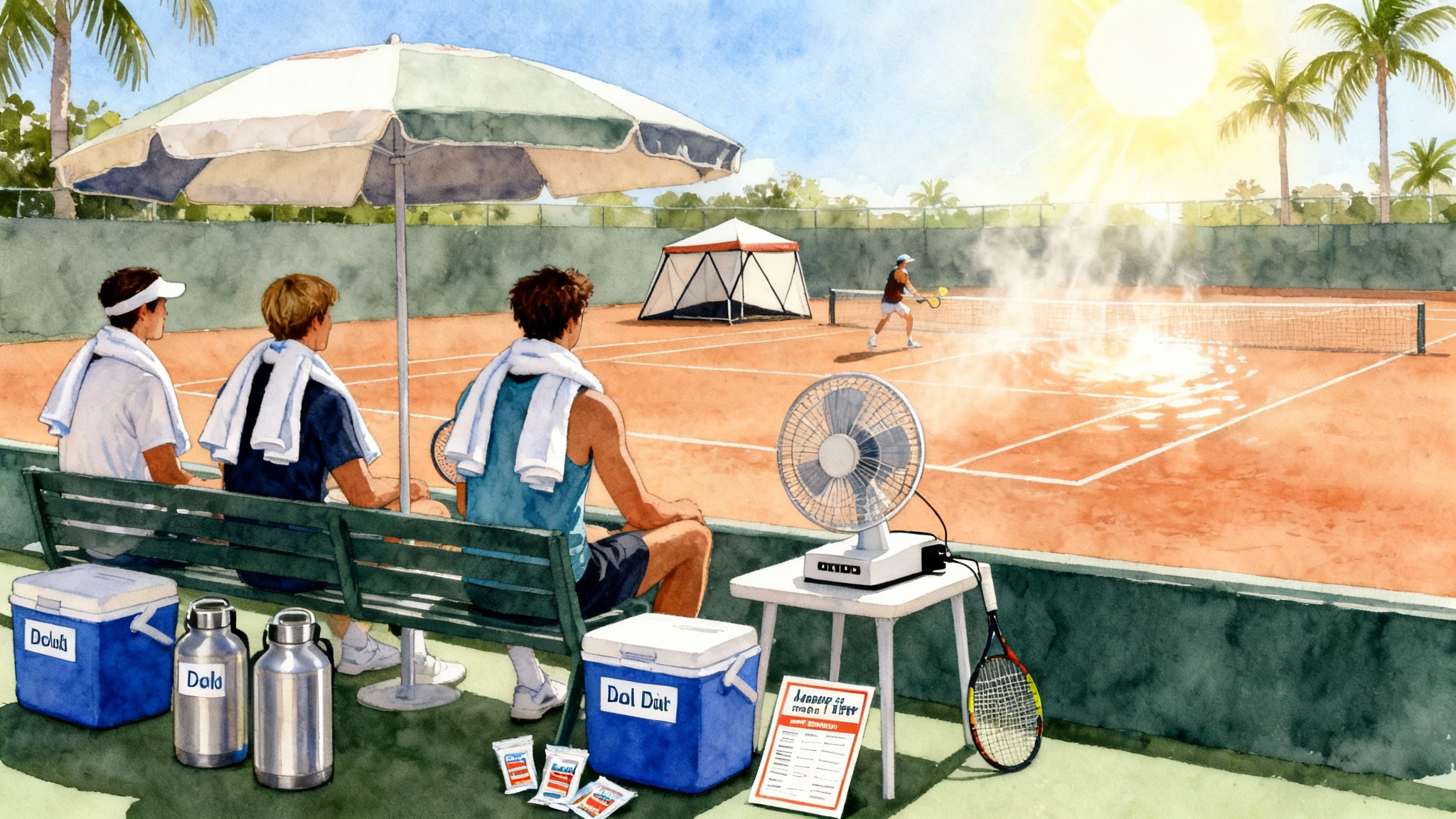
Why heat readiness in tennis is different
Tennis in summer heat is not a steady jog. It is a stop-start sport with surges, long changeovers, and sometimes hours between matches. That rhythm tricks players into thinking they are fine until cramps or heat illness arrive in a single game. Heat readiness is a skill you can train. This guide gives you a tournament-day playbook built around the heat index, with age-specific fluid and sodium targets, practical cooling strategies, a packable kit, cramp triage, and a Florida case study you can copy. Pair your heat plan with the in-season tennis strength plan and footwork pattern training to keep mechanics sharp when courts get sticky.
The heat-index tiers that drive your plan
If you can only check one number on tournament day, check the heat index. The heat index blends air temperature and humidity to estimate how hot it feels. Categories used by weather agencies are useful benchmarks: Caution, Extreme Caution, Danger, and Extreme Danger. See the National Weather Service heat index categories to match your local forecast.
Here is a simple tier system you can apply to tennis days.
- Tier 1, Moderate Caution: heat index 80 to 89 degrees Fahrenheit
- Tier 2, High Caution: 90 to 99 degrees Fahrenheit
- Tier 3, Very High Caution: 100 to 104 degrees Fahrenheit
- Tier 4, Extreme Risk: 105 degrees Fahrenheit and above
You will scale fluids, sodium, cooling, and recovery up the tiers. The hotter and more humid it is, the more you pre-cool, the more you replace sodium, and the more you enforce shade and rest.
Age-specific fluid and sodium targets
Terms we use
- Milliliter means one thousandth of a liter. One U.S. fluid ounce is about 30 milliliters.
- Sodium is the main electrolyte lost in salty sweat. Milligram is one thousandth of a gram.
Pre-match hydration for all ages
- Two to three hours before first ball: 5 to 7 milliliters per kilogram of body mass of fluids, with some sodium and carbohydrate. That is roughly 0.08 to 0.10 fluid ounces per pound. Example: a 90 pound junior takes 7 to 9 ounces. An adult at 160 pounds takes 13 to 16 ounces.
- Ten to twenty minutes before warmup: 3 to 5 milliliters per kilogram. Example: 90 pound junior takes 4 to 6 ounces. 160 pound adult takes 6 to 9 ounces. In Tier 3 and Tier 4, make at least half of this a cold sports drink or ice slurry.
During match changeovers and set breaks
- Under 12 years: 4 to 6 ounces per changeover in Tier 1 and Tier 2. 6 to 8 ounces per changeover in Tier 3 and Tier 4.
- Ages 13 to 17: 6 to 10 ounces per changeover in Tier 1 and Tier 2. 8 to 12 ounces per changeover in Tier 3 and Tier 4.
- Adults: 8 to 12 ounces per changeover in Tier 1 and Tier 2. 10 to 14 ounces per changeover in Tier 3 and Tier 4.
Hourly caps and checks
- Aim for 0.3 to 0.6 liters per hour for younger juniors, 0.4 to 0.8 liters per hour for teens, and 0.5 to 1.0 liters per hour for adults. More is not always better. If you are gaining body mass during play, you are overdrinking plain fluids and diluting sodium.
Sodium replacement by tier
- Tier 1: 200 to 300 milligrams per hour
- Tier 2: 300 to 500 milligrams per hour
- Tier 3: 500 to 800 milligrams per hour
- Tier 4: 700 to 1,000 milligrams per hour
How to hit sodium targets
- Typical sports drinks range from 230 to 500 milligrams per liter. Read the label and do the math for your hourly volume.
- Salt capsules often supply 200 to 300 milligrams each. Use with fluids, not alone.
- Real-food options: salted pretzels, salted rice balls, broth, or small shots of pickle brine. Pair salt with fluids so it can be absorbed.
Signs you need more sodium now
- Cramps that begin in the calves or forearms, salty white coating on skin, headache without stomach fullness, or a sudden drop in perceived power during rallies.
Pre-match and between-match timelines
Night before
- Eat a normal balanced dinner with carbohydrates, protein, and salt. Pasta with meat sauce and a side of salted vegetables works. Pack your kit and freeze two bottles half full of sports drink for tomorrow’s slurries.
Tournament morning
- Wake up two to three hours before first match time. Drink your pre-load target. Eat a light breakfast you already tolerate: oatmeal with banana and peanut butter, or toast with eggs and a small yogurt, plus a pinch of salt.
- Check the heat index tier. Set phone alarms for changeover drinking and between-match feeding.
Arrival, 60 to 45 minutes out
- Shade first. Set up your chair, umbrella, and a small cooler on the most shaded spot you can find.
- Begin sipping cool fluids. In Tier 3 and Tier 4 do a 6 to 8 ounce ice slurry ten minutes before dynamic warmup.
Warmup, 25 to 10 minutes out
- Mobility and footwork in shade. Keep a cold towel on the back of your neck during bands and activation drills.
- Last sips. Hit the 3 to 5 milliliters per kilogram top up.
During the match
- Every changeover: drink the target amount for your age and tier. Take small salty bites if the set is long.
- Cooling: cold towel to neck and forearms for 30 to 60 seconds. Face mist or water splash if available. In Tier 3 and Tier 4, prioritize shade over ball shadow chatting.
Between matches, short turnaround under two hours
- First five minutes: sit in shade, shoes off, feet dry, snack with sodium. Examples: salted crackers with cheese sticks, a banana with salted peanut butter.
- First 30 minutes: 16 to 24 ounces of mixed fluids. Include at least 300 to 500 milligrams of sodium if Tier 2 or higher.
- Last 20 minutes before next warmup: 6 to 8 ounce ice slurry in Tier 3 and Tier 4. Reset your towel ice and restock changeover bottles.
Between matches, long turnaround over two hours
- Small meal within 45 minutes: sandwich with turkey, cheese, and mustard, plus grapes. Include a salty component.
- Fluids: 0.3 to 0.5 liters per hour of easy sipping. Add 300 to 500 milligrams of sodium in Tier 3 and Tier 4 across the window.
- Nap in shade or indoor cool. Reapply sunscreen. Do a five minute mobility reset one hour before the next warmup.
Cooling strategies that work on court
Ice slurries
- How they help: partly frozen fluid absorbs body heat as it melts in your stomach, which helps reduce core temperature. A practical dose is 6 to 8 ounces ten minutes pre-warmup and again at first set break in Tier 3 and Tier 4.
- How to make: freeze a sports drink bottle until half solid, then shake. Or blend ice with sports drink into a slushy. Keep in a soft flask inside your cooler.
Cold towels
- Setup: soak a thin cotton towel in icy water, wring lightly, fold, and store in a zip bag on ice. Apply to the back of the neck, forehead, and forearms during changeovers for 30 to 60 seconds.
Shade and airflow
- Portable umbrella or pop-up shade reduces radiant load. A small battery fan aimed at the face and chest speeds evaporation if you are sweaty. Shade beats standing in the sun arguing about a line call.
Forearm immersion
- If a site has a sink or tub, immersing forearms up to the elbow in cool water for two minutes between sets can lower skin temperature and reduce thermal strain. Do not attempt this if it keeps you from changeover fluids and sodium.
Cooling order of operations in Tier 3 and Tier 4
- Sit in shade
- Drink your changeover target
- Cold towel neck and forearms
- Fan to face and chest
- Optional quick ice slurry if set break
Emergency cramp triage on court
Cramps can be multifactorial. Fatigue, pacing errors, and nerve hyperexcitability contribute, but in heat and heavy sweat the most actionable lever is sodium and rapid cooling. Here is a clear, coach-and-parent friendly decision path. It reflects best practice from sports medicine groups such as the National Athletic Trainers’ Association. For a deep dive, see the NATA heat illness position statement.
Step by step
- Stop play. Sit the player in shade. Shoes off to reduce foot cramping.
- Quick screen. If there is confusion, fainting, hot and dry skin, vomiting that prevents drinking, or cramps that do not release, call emergency services and begin whole-body cooling with ice towels while waiting.
- If the player is alert and can drink: give 8 to 12 ounces of a salty drink immediately. If available, add a 200 to 300 milligram sodium capsule with water. Follow with slow, deep static stretches until the muscle releases. Do not bounce.
- Cool the body. Cold towel to neck and forearms. Fan to face and chest. If you have a slushy, give another 4 to 6 ounces after five minutes.
- Resume only if cramps fully resolve, the player feels steady, and you can maintain sodium and fluid intake. If cramps recur, retire and focus on recovery. Returning too soon often triggers a cascade of cramps.
Aftercare
- Eat a salty snack and continue sipping a sports drink for the next hour. Plan for an earlier sodium strategy in the next match.
The travel kit you can build this week
Your kit should fit in a rolling soft cooler and one duffel.
Cooling and shade
- Two thin cotton towels, one microfiber towel
- Quart-size zip bags for ice refills at the site
- Battery fan with spare batteries or a power bank
- Compact umbrella or lightweight pop-up shade
Fluids and sodium
- Two insulated jugs per player: one plain water, one sports drink
- Two soft flasks for slurries, pre-frozen bottles
- Sodium capsules labeled 200 to 300 milligrams each
- Bag of salted snacks: pretzels, crackers, trail mix
- A few oral rehydration packets for emergencies
On-court comfort and hygiene
- Extra socks and a small container of foot powder
- Athletic tape and a small blister kit
- Cooling cloth for neck, sunscreen, lip balm, insect repellent
Data and tools
- Small digital scale for before and after weights to estimate sweat rate
- Thermometer if you like to log environment, or rely on your phone weather app
Paper plan
- A one-page sheet with your age-specific drink amounts by tier, changeover routine, and cramp triage steps. Laminate it. When the match is tight, the paper makes decisions easier.
Front
- Today’s heat index tier
- Changeover drink volumes by age
- Sodium per hour target by tier
Back
- Cooling routine order
- Cramp triage steps
- Emergency contacts and tournament desk number
Final serve
Heat readiness is not a guess or a gut check. It is a small set of numbers, a few cooling habits, and a kit you can load in ten minutes. Build your plan around the heat index. Scale fluids and sodium by age and by tier. Treat cooling as a skill. Practice the cramp triage steps so parents and players act fast when a rally turns into a calf seize. The payoff is real. In the fifth game of the second set, when the sun bites and the legs of the unprepared go heavy, your player still moves to the short ball and finishes with confidence.
